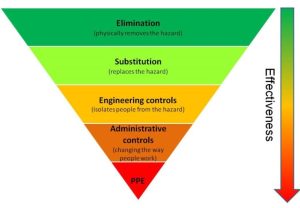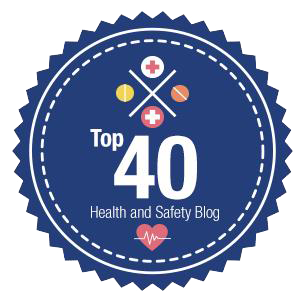
Understanding common electrical signs, symbols and labels
Electricity is an essential part of our everyday lives and is present in most, if not all, workplaces and homes. Despite its usefulness, it is dangerous, as contact with it can result in death or severe injuries. It can also cause damage to property from electrical-related fires and explosions.
Every year, approximately 1,000 accidents (30 of these fatal) at work involving electric shock or burns are reported to the Health and Safety Executive (HSE). Most fatalities are caused by contact with overhead or underground power cables. Even where electric shocks are not fatal, they can still result in permanent life-changing injuries.
Electrical-related fires are not uncommon either. In the Fire and Rescue Services statistics for England (2019/2020), there were:
Those who work directly with electricity, e.g. engineers, electricians and overhead lines staff, are at a higher risk. However, it is also a risk for other workers and the public who use electrical equipment and appliances at work and at home.
The dangers of electricity are often underestimated, especially in low-risk environments such as offices and when people are at home. The mains electrical supply in these types of environment is 230 volts, which may seem low. However, to put this into perspective, a voltage of just 50 volts is enough to cause the heart to stop and prevent breathing. Therefore, everyone must take electrical safety seriously, whether they are at work or at home.
If there is a risk of electrical injuries at work, employers have a legal duty to prevent, reduce or control the risks. It requires them to put precautions in place, e.g. providing employees with electrical safety training and information and instruction via safety signs and labels.
Avoiding electrical hazards
A hazard is something that has the potential to cause harm. Risk is the likelihood of harm occurring and the severity should it happen. Electricity is a hazard that can cause death, severe injuries and property damage, and it is a risk in almost all workplaces and homes.
The hazards present and the level of risk will depend on:
Common electrical hazards
Some examples of common electrical hazards include:
Electrical accidents can occur for many different reasons, such as:
There are many precautions that can minimise electrical safety risks and far too many to mention in this article.
Some examples include:
Further information on electrical hazards and precautions can be found on the HSE’s electricity webpage and in their electrical safety guidance.
There are many different measures to prevent, control or reduce the risks of electrical hazards. Those selected must reduce the electrical risks to the lowest possible level. One of the measures used is electrical safety signs.
Electrical safety signs and symbols
Before providing safety signs, employers must first look at eliminating electrical hazards wherever possible, e.g. using non-electrical equipment. If it is not possible, they should then look at other means of avoiding or controlling the risk. For example, they can substitute higher voltage equipment for lower voltage or battery-powered equipment.
Electrical safety signs are examples of administrative controls. They are lower in the hierarchy as they do not remove the hazard. However, they are still important control measures. Safety signs can reduce the risk by providing information on the hazard and giving instructions on preventing exposure.
A safety sign is defined in the Safety Signs and Signals Approved Code of Practice as “a sign providing information or instruction about safety or health at work by means of a signboard, a colour, an illuminated sign or acoustic signal, a verbal communication or hand signal”.
The purpose of safety signs is to communicate health and safety information to workers and others at risk from the hazard.
There are five main categories of safety sign:
All safety signs should have the appropriate universal symbols or pictograms to account for those who have difficulty reading and limited English skills. Signs displaying just text will not be compliant. Some have supplementary text (usually at the bottom) with further information on the hazard or instructions. If text is used, it must meet the category of the sign.
Faulty, damaged and defective electrical equipment is a common cause of accidents and is often due to a lack of maintenance. Electrical appliances and equipment should be subject to regular maintenance to identify any issues that could create a risk to users or others. Portable appliance testing (PAT), also known as PAT testing, is an example of an effective maintenance method.
According to the HSE, PAT testing is “the term used to describe the examination of electrical appliances and equipment to ensure they are safe to use”. The Institution of Engineering and Technology (IET) refer to it as the in-service inspection and testing of electrical equipment.
PAT testing involves a combination of visual inspections and electronic tests. After an electrical item has been PAT tested, labels are often attached to indicate the test date and whether it is safe or not.
They usually contain the following information:
PAT labels do vary, and there are many different types, for example:
There is not a specific requirement for PAT labels to be a particular colour, size or shape. However, PAT labels are covered in the IET Code of Practice for In-Service Inspection and Testing of Electrical Equipment. The Code of Practice is widely accepted, and many PAT label suppliers will follow the requirements within.
Regulations and standards
The Electricity at Work Regulations 1989
The main law relating to electrical safety is the Electricity at Work Regulations 1989. These regulations place duties on employers, the self-employed and employees. It aims to prevent and reduce the risk of death and injury from electricity in the workplace.
The main requirements of the regulations are as follows:
The Health and Safety (Safety Signs and Signals) Regulations 1996
The requirement for electrical safety signs comes under the Health and Safety (Safety Signs and Signals) Regulations 1996. Where there is a significant electrical risk that cannot be eliminated or controlled by other methods, employers must provide safety signs and maintain them by law. The Safety Signs and Signals Approved Code of Practice provides further guidance on the requirements of the regulations.
When and where to use safety signs should be based on the findings of the risk assessment. They should only be used where they can further reduce the risk. They should be clear and legible, and employers should avoid using too many signs, as it can confuse people.
To comply with the regulations, employers must also provide employees with suitable and sufficient instruction and training in the meaning of safety signs, including the measures to take in connection with them.
BS EN ISO 7010 is an international standard. According to the British Standards Institution (BSI), BS EN ISO 7010 standardises the look of safety signs and their meaning for international use and for the purposes of accident prevention, fire protection, health hazard information and emergency evacuation. The shape and colour of each safety sign and the design of the graphical symbols is according to ISO 3864 series.
ISO 7010 was introduced so that safety signs were consistent across Europe. In 2013, it became a European Normative (EN), which meant it was adopted by European Law. As a result, all member states had to adopt the standard, which included the UK. The UK has now left the EU, but BS EN ISO 7010 is the British version of the standard and still applies.
It is important to note that British Standards are not law. However, BS EN ISO 7010 is referred to in the Safety Signs and Signals Approved Code of Practice (ACOP), which provides guidelines on complying with the Health and Safety (Safety Signs and Signals) Regulations 1996. An ACOP is a legal series publication, and the HSE can use it as evidence of non-compliance with the regulations. Therefore, it is wise for employers to follow the standard with regards to their safety signs.
There is no legal requirement to carry out PAT testing, but it is an effective way of showing that electrical equipment has been effectively maintained. Maintenance is a legal requirement under the Electricity at Work Regulations 1989 and the Provision and Use of Work Equipment Regulations (PUWER) 1998. The frequency of PAT testing should always be based on the findings of a risk assessment.
There is also no legal requirement to use PAT labels, but it is recommended as it shows that the equipment has been tested, the result and the date of the test. It also provides evidence that an effective maintenance regime is in place.
There are guidelines for PAT testing, including labels, in the IET’s Code of Practice for In-service Inspection and Testing of Electrical Equipment, 5th Edition.
Electricity can kill people. It can also cause severe injuries and damage to property. Therefore, electrical safety must be taken seriously by all those who may be directly or indirectly exposed to electricity.
Electrical signs and symbols provide workers and others with information on electrical hazards and instructions on preventing harm. Labels, such as those used in PAT testing, inform people that electrical equipment and appliances are safe to use or not. Signs, symbols and labels are a useful way of communicating health and safety information to employees and others, which can reduce the risks.
Employers have many legal duties regarding electrical safety in the workplace. They should use the top options in the hierarchy of control to prevent and reduce the risks in the first instance. If this isn’t possible, safety signs can be used where the remaining risks are significant. If safety signs are used as a control measure, employers must ensure they comply with the relevant laws and standards. It is also vital to ensure that those at risk from electricity understand the message to keep themselves and others safe.
Contact us for further information.










